1998 CHEVROLET ASTRO window
[x] Cancel search: windowPage 155 of 414
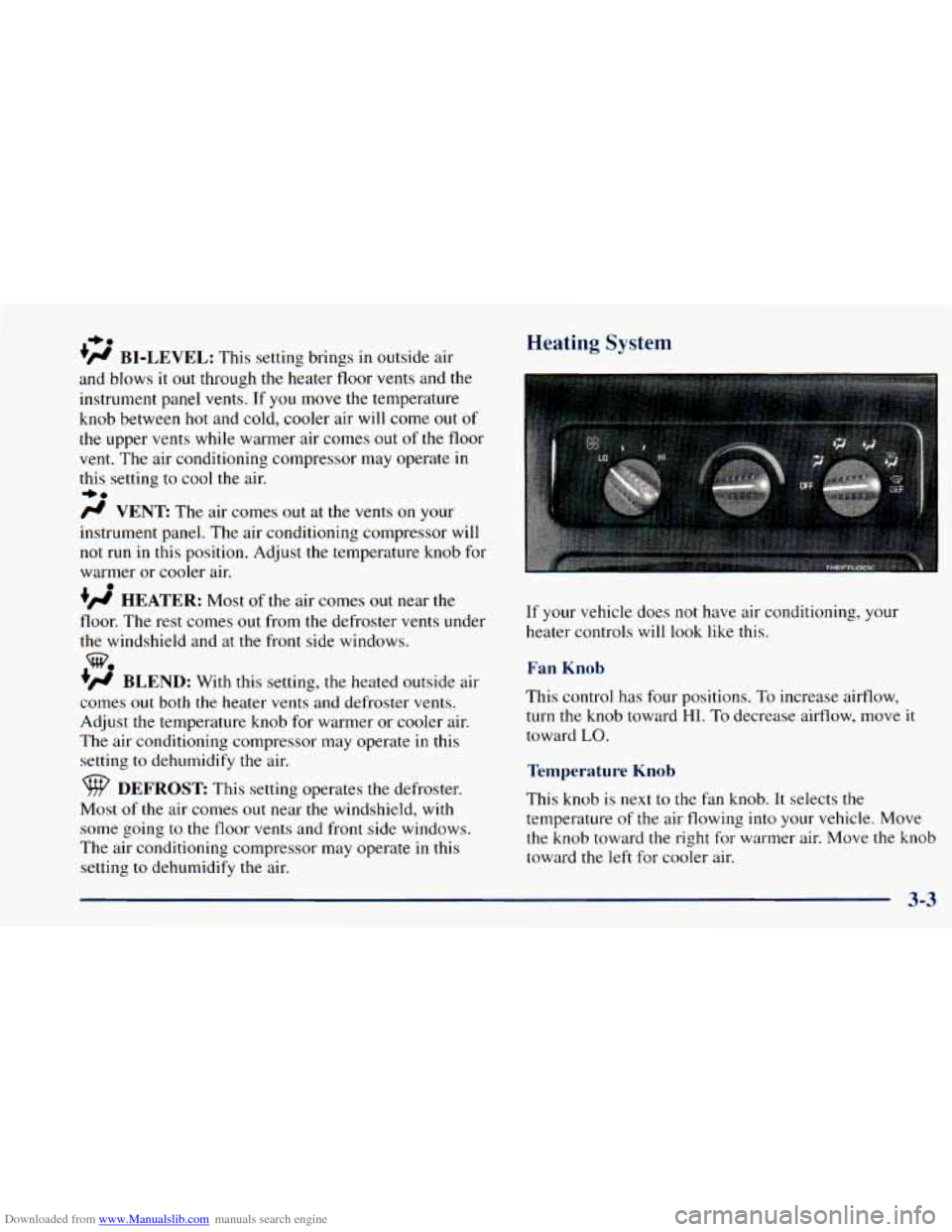
Downloaded from www.Manualslib.com manuals search engine -bo
+@ BI-LEVEL: This setting brings in outside air
and blows
it out through the heater floor vents and the
instrument panel
vents. If you move the temperature
knob between hot and cold, cooler air will come
out of
the upper vents while warmer air comes out of the floor
vent. The air conditioning compressor may operate in
this setting to cool the air.
/J VENT The air comes out at the vents on your
instrument panel. The air conditioning compressor will
not run in this position. Adjust the temperature knob for
warmer or cooler air.
+' HEATER: Most of the air comes out near the
floor. The rest comes
out from the defroster vents under
the windshield and at the front side windows.
+, BLEND: With this setting, the heated outside air
comes out both the heater vents and defroster vents.
Adjust the temperature knob for warmer or cooler air.
The air conditioning compressor may operate in this
setting
to dehumidify the air.
rl*.
0
w.
DEFROST This setting operates the defroster.
Most
of the air comes out near the windshield, with
some going
to the floor vents and front side windows.
The air conditioning compressor may operate in this
setting to dehumidify the air.
Heating System
If your vehicle does not have air conditioning, your
heater controls will look like this.
Fan Knob
This control has four positions. To increase airflow,
turn
the knob toward HI. To decrease airflow, move it
toward
LO.
Temperature Knob
This knob is next to the fan knob. It selects the
temperature of the air flowing into your vehicle. Move
the knob toward the right for warmer air. Move
the knob
toward
the left for cooler air.
3-3
Page 156 of 414
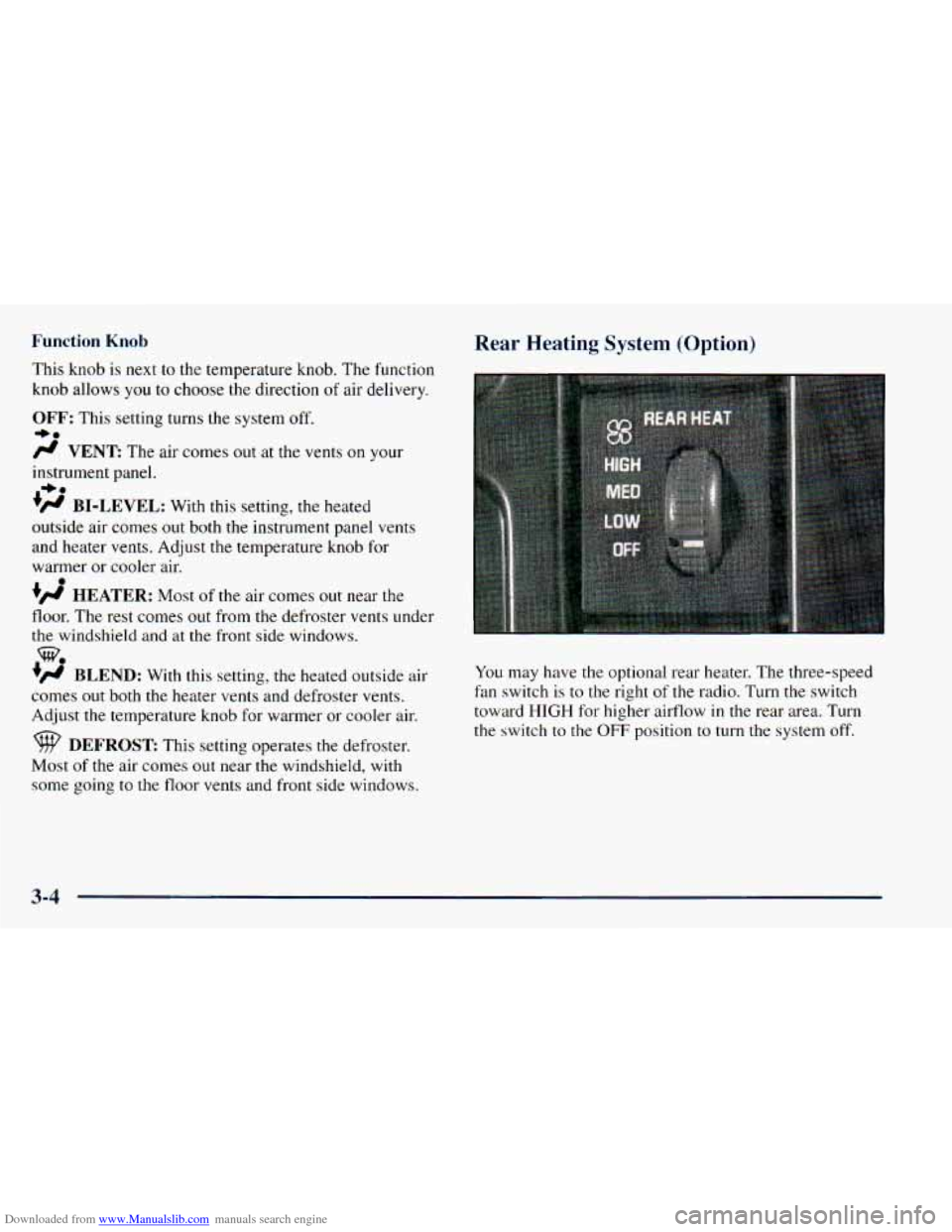
Downloaded from www.Manualslib.com manuals search engine Function Knob
This knob is next to the temperature knob. The function
knob allows you to choose the direction
of air delivery.
OFF: This setting turns the system off.
+*
P@ VENT: The air comes out at the vents on your
instrument panel.
'' BI-LEVEL: With this setting, the heated
outside air comes
out both the instrument panel vents
and heater vents. Adjust the temperature knob for
warmer or cooler air.
+P@ HEATER: Most of the air comes out near the
floor. The rest comes out from
the defroster vents under
the windshield and at the front side windows.
+d BLEND: With this setting, the heated outside air
comes out both the heater vents and defroster vents,
Adjust
the temperature knob for warmer or cooler air.
+e
0
DEFROST This setting operates the defroster.
Most of the air comes
out near the windshield, with
some going
to the floor vents and front side windows.
Rear Heating System (Option)
You may have the optional rear heater. The three-speed
fan switch is to the right
of the radio. Turn the switch
toward
HIGH for higher airflow in the rear area. Turn
the switch to the
OFF position to turn the system off.
3-4
Page 157 of 414
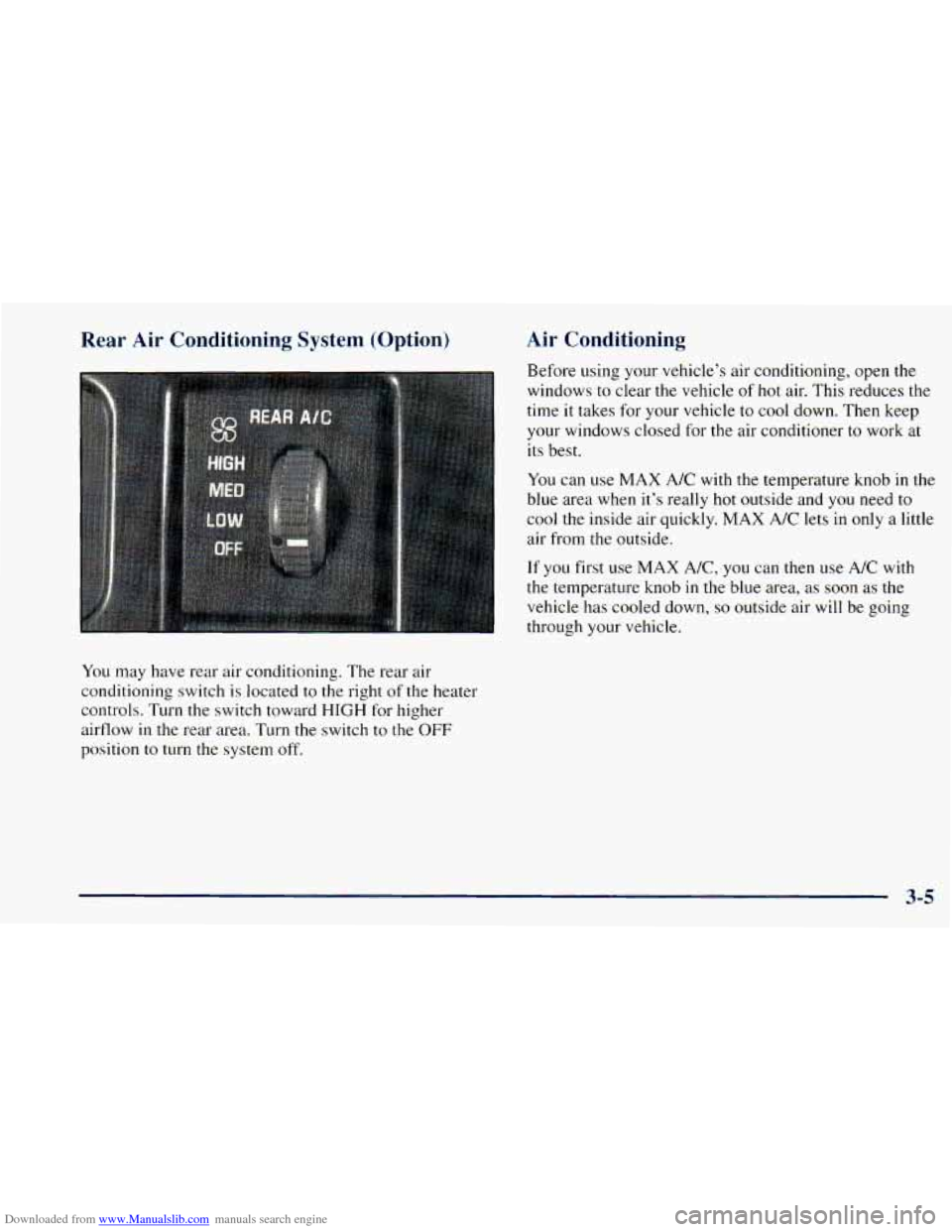
Downloaded from www.Manualslib.com manuals search engine Rear Air Conditioning System (Option) Air Conditioning
Before using
your vehicle’s air conditioning, open the
windows to clear the vehicle
of hot air. This reduces the
time
it takes for your vehicle to cool down. Then keep
your windows closed for the air conditioner to work at
its best.
You can use
MAX A/C with the temperature knob in the
blue area when it’s really
hot outside and you need to
cool the inside air quickly.
MAX A/C lets in only a little
air from the outside.
If you first
use MAX A/C, you can then use A/C with
the temperature knob
in the blue area, as soon as the
vehicle has cooled down,
so outside air will be going
through your vehicle.
You may have rear air conditioning. The rear air
conditioning switch is located
to the right of the heater
controls. Turn the switch toward
HIGH for higher
airflow in the rear area. Turn the switch to the
OFF
position to turn the system off.
3-5
Page 158 of 414
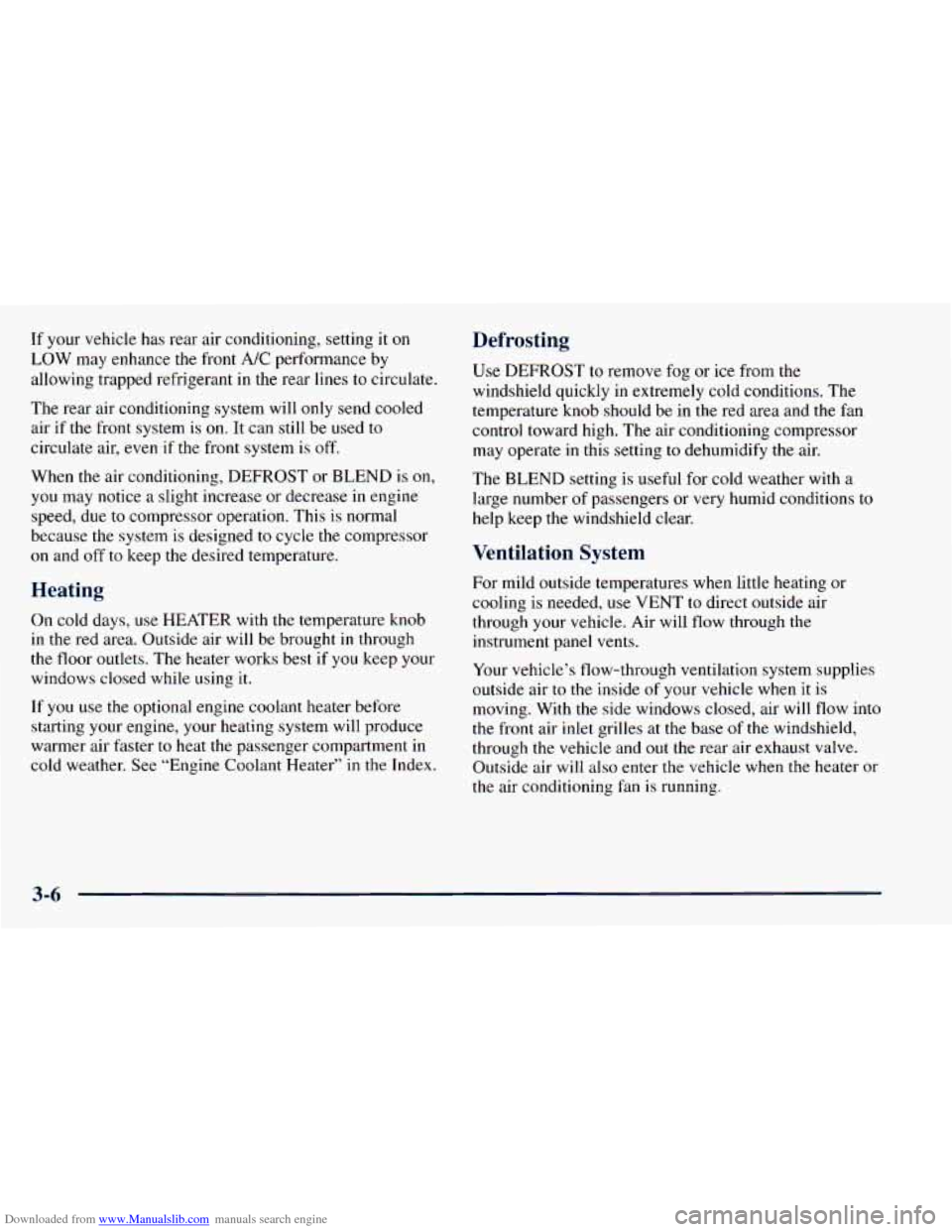
Downloaded from www.Manualslib.com manuals search engine If your vehicle has rear air conditioning, setting it on
LOW may enhance the front
A/C performance by
allowing trapped refrigerant in
the rear lines to circulate.
The rear air conditioning system will
only send cooled
air if the front system is
on. It can still be used to
circulate air,
even if the front system is off.
When the air conditioning, DEFROST or BLEND is on,
you may notice a slight increase or decrease in engine
speed, due to compressor operation. This is normal
because the system is designed
to cycle the compressor
on and off to keep the desired temperature.
Heating
On cold days, use HEATER with the temperature knob
in the red area. Outside air will be brought in through
the floor outlets. The heater works best if you keep your
windows closed while using it.
If you use the optional engine coolant heater before
starting your engine, your heating system
will produce
warmer air faster
to heat the passenger compartment in
cold weather. See “Engine Coolant Heater” in the Index.
Defrosting
Use DEFROST to remove fog or ice from the
windshield quickly in extremely cold conditions. The
temperature knob should be in the red area and the fan
control toward high. The air conditioning compressor
may operate
in this setting to dehumidify the air.
The BLEND setting is useful for cold weather with
a
large number of passengers or very humid conditions to
help keep the windshield clear.
Ventilation System
For mild outside temperatures when little heating or
cooling is needed, use VENT
to direct outside air
through your vehicle. Air will flow through the
instrument panel vents.
Your vehicle’s flow-through ventilation system supplies
outside air to the inside of your vehicle when it is
moving. With the side windows closed, air will flow into
the front air inlet grilles at the base of the windshield,
through the vehicle and
out the rear air exhaust valve.
Outside air will also
enter the vehicle when the heater or
the air conditioning fan is running.
3-6
Page 159 of 414
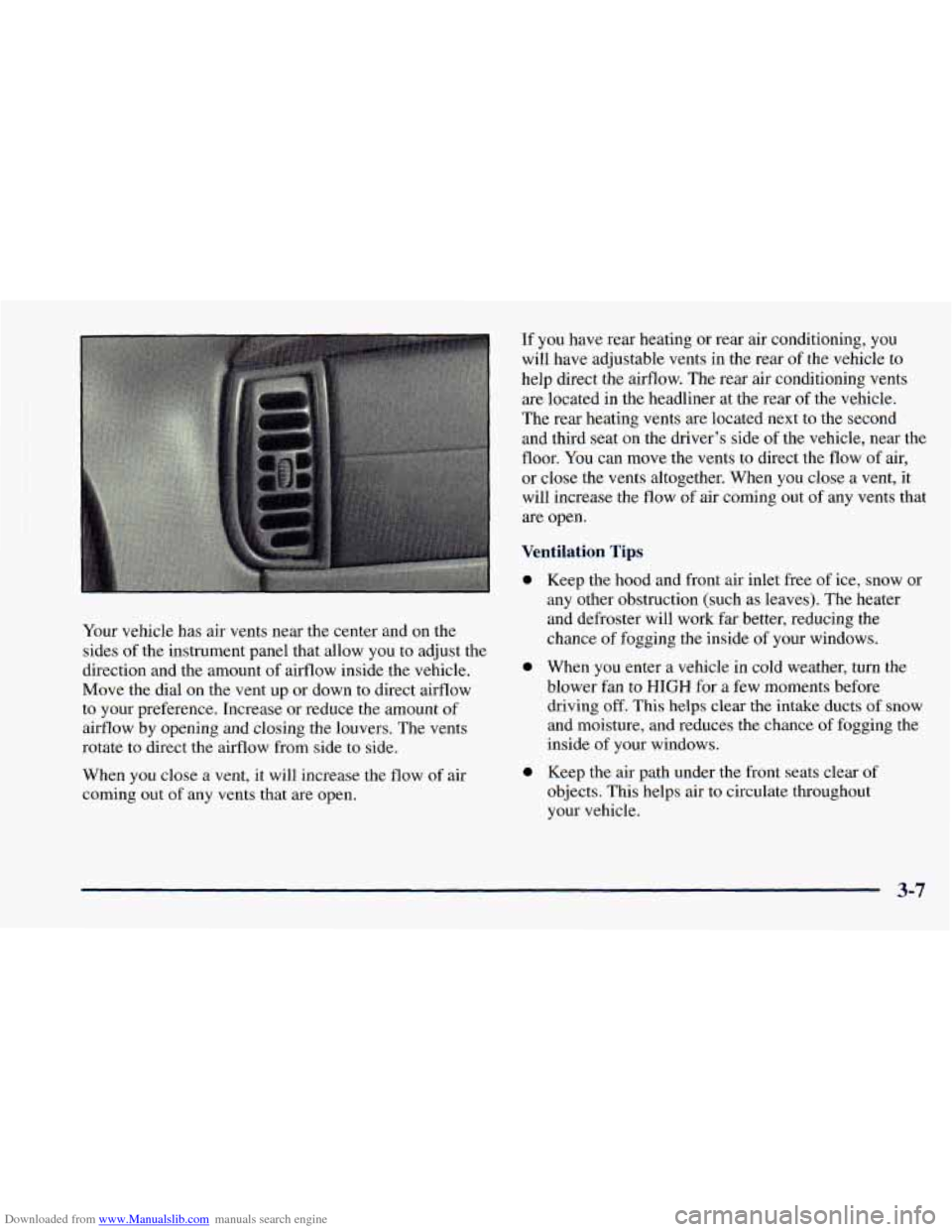
Downloaded from www.Manualslib.com manuals search engine Your vehicle has air vents near the center and on the
sides of the instrument panel that allow you to adjust the
direction and the amount of airflow inside the vehicle.
Move the dial on the vent up or down to direct airflow
to your preference. Increase or reduce the amount of
airflow by opening and closing the louvers. The vents
rotate to direct the airflow from side to side.
When you close a vent, it will increase the flow of air
coming out of any vents that are open. If you
have rear heating or rear air conditioning, you
will have adjustable vents in the rear of the vehicle to
help direct the airflow. The rear air conditioning vents are located in the headliner at the rear
of the vehicle.
The rear heating vents are located next to the second
and third seat
on the driver’s side of the vehicle, near the
floor.
You can move the vents to direct the flow of air,
or close the vents altogether. When you close a vent, it
will increase the flow of air coming out of any vents that
are open.
Ventilation Tips
e
e
a
Keep the hood and front air inlet free of ice, snow or
any other obstruction (such as leaves). The heater
and defroster will work
far better, reducing the
chance
of fogging the inside of your windows.
When you enter a vehicle in cold weather, turn the
blower fan to HIGH for
a few moments before
driving off.
This helps clear the intake ducts of snow
and moisture, and reduces the chance of fogging the
inside of your windows.
Keep the air path under the front seats clear of
objects. This helps air to circulate throughout
your vehicle.
3-7
Page 160 of 414

Downloaded from www.Manualslib.com manuals search engine Rear Window Defogger (Option)
If your vehicle has this option, the rear window will
have lines running across the glass.
These lines heat
your window.
For best results, clear the window of
as much snow or
ice as possible before using the rear window defogger.
To turn on the rear window
defogger, find the button to
the left of the heater
controls with
the defog
symbol on it.
Press
the button until the light comes on, then release it.
The rear window defogger will only work when the
ignition switch is in the
RUN position.
You
can turn the defogger off at any time by pressing
the button again. The defogger will shut itself off after
several minutes
so that the glass does not get too hot. If
the window
still isn’t clear, turn the defogger on again.
Do not attach a temporary vehicle license, tape or decals
across the defogger grid
on the rear window.
1 NOTICE: 1
Don’t use a razor blade or something else sharp
on the inside of the rear window. If you do, you
could cut or damage the defogger and the repairs
would not be covered by your warranty.
3-8
Page 204 of 414

Downloaded from www.Manualslib.com manuals search engine Here are some things you can check before a trip:
0
0
0
0
0
0
0
Windshield Washer Fluid: Is the reservoir full? Are
all windows clean inside and outside?
Wiper Blades: Are they in good shape?
Fuel, Engine Oil, Other Fluids: Have you checked
all levels?
Lamps: Are they all working? Are the lenses clean?
Tires: They are vitally important to a safe,
trouble-free trip.
Is the tread good enough for
long-distance driving? Are the tires
all inflated to the
recommended pressure?
Weather Forecasts: What’s the weather outlook
along your route? Should you delay your trip a short
time
to avoid a major storm system?
Maps: Do you have up-to-date maps?
Highway Hypnosis
Is there actually such a condition as “highway
hypnosis”? Or is
it just plain falling asleep at the wheel?
Call
it highway hypnosis, lack of awareness,
or whatever.
There
is something about an easy stretch of road with
the same scenery, along with the hum
of the tires on the
road, the drone of the engine, and the rush of the wind
against the vehicle that can make
you sleepy. Don’t let it
happen to you!
If it does, your vehicle can leave the
road
in less than a second, and you could crash and
be injured.
What can
you do about highway hypnosis? First, be
aware that it can happen.
Then here are some tips:
0 Make sure your vehicle is well ventilated, with a
comfortably cool interior.
0 Keep your eyes moving. Scan the road ahead and
to the sides. Check your mirrors and your
instruments frequently.
If you get sleepy, pull off the road into a rest, service
or parking area and take
a nap, get some exercise, or
both. For safety, treat drowsiness on
the highway as
an emergency.
Page 209 of 414

Downloaded from www.Manualslib.com manuals search engine Tie a red cloth to your vehicle to alert police that
you’ve been stopped by the snow.
Put on extra clothing or wrap a blanket around you.
If you have no blankets or extra clothing, make body
insulators from newspapers, burlap bags, rags, floor
mats
-- anything you can wrap around yourself or
tuck under your clothing
to keep warm.
Sr Y can trap exha. ler your vehicle.
~ This can cause deadly 60 (carbon monoxide) gas
to get inside. CO could overcome you and kill
you.
You can’t see it or smell it, so you might not
know
it is in your vehicle. Clear away snow from
around the base of your vehicle, especially any
~ that is blocking your exhaust pipe. And check
around again from time to time to be sure snow
doesn’t collect there.
Open a window just
a little on the side of the
vehicle that’s
away from the wind. This will help
~ keep CO out.
Run your engine only as long as you must. This saves
fuel. When you run
the engine, make it go a little faster
than just idle. That is, push the accelerator slightly. This
uses less fuel for the heat that you get and it keeps the
battery charged. You will need a well-charged battery
to
restart the vehicle, and possibly for signaling later on
with your headlamps. Let
the heater run for a while.
You can run the engine to keep warm, but be careful.
4-25